
Food is one of life’s greatest pleasures, whether it is cooked to perfection and presented artistically in a restaurant or eaten happily and care-free around the family kitchen table.
However, with the use of knives, flames, boiling liquids and hot ovens often involved, it is important that we never underestimate or forget the risks and dangers associated with the kitchen and food preparation.
The Royal Society for the Prevention of Accidents (RoSPA) identifies the home as the most common location for accidents and, in a survey by the National Accident Helpline, exploring causes of accidents in the home, 60% of respondents stated that they had injured themselves when preparing food. The kitchen is an area of the home where we need to be most alert and mindful of risks.
Even in professional kitchens, accidents can happen. In a 2019/20 report, the Labour Force Survey found that the accommodation and food service industries had a higher than average number of estimated non-fatal injuries per 1000 workers when compared to other industries. With an estimated 170,000 working days lost to injuries in the 12 months prior to the 2019/20 report, health and safety provisions need to be a priority for the hospitality sector.
How to prevent the most common kitchen accidents
What are the most common kitchen accidents?
The National Accident Helpline survey identified the top five household objects that had the highest chance of causing injury. Three of these are common in kitchens, both in our homes and in commercial venues: kitchen knives (49%), hobs (24%) and wet floors (18%).
Cuts in the Kitchen: safety around kitchen knives
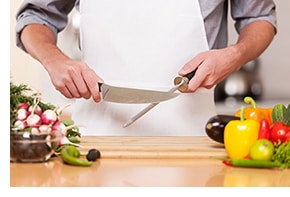
Kitchen knives were the cause of past injuries for almost half of the people surveyed by the National Accident Helpline, making them the household object most likely to cause injury. Yet it would be impossible to prepare most meals without the use of a knife. So how can we keep safe?
-
Sharper is safer. Although counter-intuitive, sharp knives are less likely to cause accidental injury than blunt knives. If we try to cut something with a blunt knife, the knife is more likely to slip. At the same time, we apply more pressure with blunt knives, as they need more force to cut through food. Combined, these two factors can create a dangerous situation.
-
Storage is significant. Thoughtful knife storage is essential and there are a number of factors to consider: accessibility, organisation and blade protection. Knives need to be easily accessible to you, but out of reach of children; they also need to be carefully organised so that you never have to rummage through a drawer of knives; additionally, some speciality knives may need a blade protector to keep them sharp.
-
Holding and using knives.
-
Choose the correct type of knife for the food that you are cutting.
-
Cut on a stable surface – never cut an object while you are holding it in your hand.
-
Keep knives out of washing up bowls – they can get lost and cut you when you put your hands in.
-
Carry knives with the blade pointing downward.
-
Use protective equipment if necessary, such as a protective glove on the non-knife hand during deboning.
-
Of course, sometimes accidents happen, no matter how careful we are.
Flames and Fire: safety around hobs and ovens
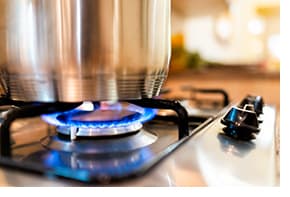
The Home Office’s ”Detailed analysis of fires” report for the year ending March 2021 identifies cooking appliances as the largest ignition category for accidental fires, making up 46% of fires. Hobs were also identified in the National Accident Helpline survey as being the third most likely household object to cause injury.
The London Fire Brigade suggest the following simple steps to significantly reduce the likelihood of burning yourself when cooking:
-
Make sure you don’t leave cooking unattended on the hob or grill; turn off the heat if you have to leave the kitchen. Similarly, double-check that you have turned off the heat once you have finished cooking.
-
Be aware of fabrics that could catch fire around a flame – think about loose clothing or tea-towels and ensure they stay away from naked flames.
-
Always use a spark device, rather than a match or lighter, to light a gas cooker, to avoid a naked flame near gas.
- Make sure your oven, hob, cooker hood, extractor fan and grill are clean, as built-up fat and grease can cause a fire.
How to keep children safe when cooking
In the home, many of us will be cooking around young children or pets and it’s important to consider how this might impact safety in the kitchen. The Children’s Burns Trust estimates an average of 110 children being seen by emergency departments for burn injuries every day. The majority of burns to children happen between 3 and 6 – around the time that dinner is prepared. Here are some basic guidelines to maximising safety:
- Keep cooking on the back ring or hotplate, if possible, to make it more difficult for children to reach and grab hot pans or spill hot liquids.
- Turn handles of pans in so that they are less easy to reach and grab.
- Never leave children unsupervised in the kitchen during cooking.
Just in case things do go wrong, it’s best to be prepared.
Slips, trips and spills: avoiding falls in the kitchen
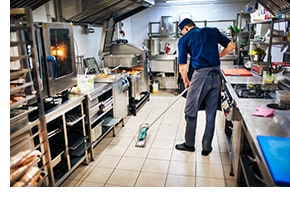 A wet floor was the fifth most common cause of injury in the house, according to the National Accident Helpline survey, yet it is something that is so easy to avoid.
A wet floor was the fifth most common cause of injury in the house, according to the National Accident Helpline survey, yet it is something that is so easy to avoid.
- Spills should be cleaned up immediately. If someone enters the kitchen unaware of the spill, they are in even more danger of slipping as a result.
- In professional environments, supplies such as our absobent powder can be particularly effective in making it easy and quick to clean. The easier that equipment is to use, the more likely staff will take the time to use it properly.
- Reduce the likelihood of a spill or fall by carefully planning storage areas. Keep heavy items on lower shelves, along with those items that are used most frequently.
- Avoid trips by ensuring all walkways are free from obstacles and well-lit.
What should a kitchen first aid kit contain?
First aid in the home
For kitchens in the home, there is no government requirement to have a first aid kit. However, having first aid provisions stored safely in a kit makes it more likely that first aid will be given quickly and effectively in an emergency.
First aid kits, such as the General Purpose First Aid Kit come in a range of sizes, depending on the size of your household, and include all the basic first aid supplies, from washproof plasters to burn dressing sachets – perfect for the kitchen.
Similarly, the Family First Aid Kit includes large quantities of plasters and dressings, burn dressings and eye wash – everything that most families could need.
Importantly, both kits contain first aid guidance leaflets, with the Family First Aid Kit also including specialised guidance for children. In emergency situations, having clear guidance such as this can boost confidence and competence of first aid provision.
Catering first aid
In professional environments, there are legal requirements that need to be met with regards to first aid and safety provision. However, the onus is very much on the employer to complete a risk assessment and determine what first aid supplies are necessary.
In terms of first-aid kits, the following table provides a simplified guide to size:
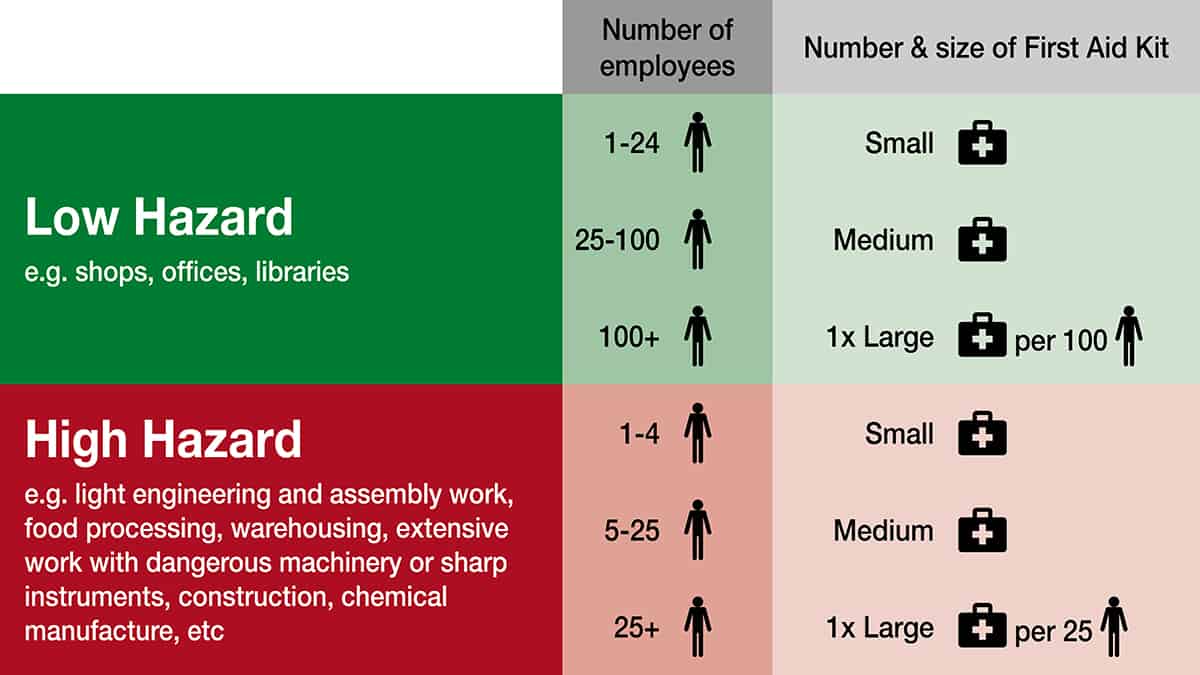
Catering businesses, however, will also need to consider the additional risks in the kitchen: burns, serious cuts and slips/falls. Choosing catering-specific first aid kits ensures that they have been compiled with the catering industry in mind, for example, providing blue-consumable plasters and dressings.
The Economy Catering First Aid Kit complies with BS 8599-1:2019, comes in a durable economy case and includes blue consumable supplies.
The BS 8599 Compliant Blue Catering First Aid Kit is designed for all food-handling environments, coming in an easily identifiable blue Evolution case. Whereas the Blue Evolution Plus Catering BS 8599 Compliant First Aid Kitalso includes adjustable shelves and a wall mounting bracket, making it easy to use and identifiable in an emergency.
First aid points allow for even greater specialisation, while increasing the visibility for first aid provisions in the workplace. The Evolution BS Compliant Catering First Aid Point comes with a separate red case containing a full range of burns supplies. Burns – a common injury in kitchens – can be treated quicky and effectively, without even having to open the main first-aid case.
First aid for cuts
How should you treat major wounds?
- Check for danger, response, airway, breathing and circulation. Protect yourself by using gloves or another improvised barrier for protection.
- Observe the casualty for the signs of hypovolaemic shock and treat if necessary.
- Sit them down.
- Expose the wound by removing or cutting off clothing.
- Inspect the wound for foreign bodies.
- Apply direct pressure over the wound to stop the bleeding.
- Apply an appropriately sized first aid dressing over the wound. If there is an object in the wound do not remove it but pack the dressing around it.
- If blood loss seeps through the first dressing, remove and reapply pressure. Once controlled, secure new dressing.
- Monitor and record.
- Consider applying a tourniquet.
How should you treat minor wounds, cuts and grazes?
- Check for danger, response, airway, breathing and circulation; protect yourself by using gloves or another improvised barrier for protection.
- Expose the wound and stop any bleeding by using pressure and a first aid dressing as above. Do not proceed to cleaning or dressing the wound unless you have stopped the bleeding.
- If there is debris in the wound, dousing it in sterile wound cleaning fluid can flush this out or tap water can be used.
- Apply a sterile non-adhesive dressing or plaster as appropriate.
- Check if there is an underlying injury for example a soft tissue injury or fracture.
- Advise the casualty to seek further medical advice if either the first aider or the casualty is concerned.
Which plasters should I use?
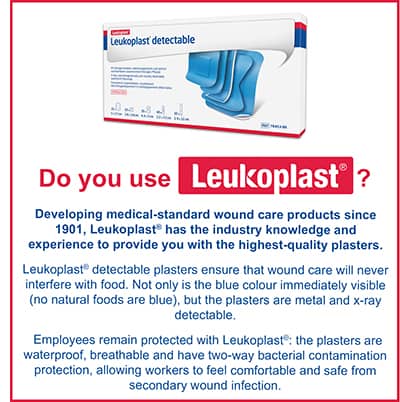 Any minor wound should be covered with a waterproof plaster, which provides a resistance to water whilst remaining adhesive. Washproof plasters are often found in first aid kits and are listed in the contents of a British Standard BS 8599-1 compliant first aid kit for the workplace.
Any minor wound should be covered with a waterproof plaster, which provides a resistance to water whilst remaining adhesive. Washproof plasters are often found in first aid kits and are listed in the contents of a British Standard BS 8599-1 compliant first aid kit for the workplace.
Blue plasters (consumables) are standard of the catering industry and areas of hospitality. The colour makes them visually detectable, helping them to comply with food hygiene legislation. Leukoplast® Detectable X-Ray Plasters also have an aluminium strip embedded into them, making them metal detectable. With a skin-friendly acrylic adhesive and waffle design, they are soft, comfortable and breathable.
First aid for burns
What is the best way to cool a burn?
All thermal burns (flame, hot liquids, hot surfaces) should be cooled as soon as possible; cooling the surface of the burn is an extremely effective analgesic. Cool, clean running water for 20 minutes (approximately 65 litres per burn injury) is the recommended international guideline. It is important to identify the heat source before cooling.
Once the burn injury is fully cooled, cling film may be layered on to the wet burn site in loose strip lengths (never wrap around head, body or limb, to avoid constriction) to cover the wound from irritation, and possible infection. Cling film should NEVER be applied to a hot burn site, it should only be used when the burn injury has been totally cooled.
If there is an extensive burn, it may be necessary to reduce the period of application of cool water from the optimal 20 minutes in order to prevent hypothermia. Hypothermia should be prevented at all costs.
Do burns patients need to be kept warm?
A burns patient must be kept warm:
- Heat the room where the patient is being treated.
- Use warm blankets.
- Administer humidified oxygen (if available).
- Resuscitation fluids should be warmed prior to infusion.
- Cool only the burn injury, if possible, keeping it small and shallow.
In short, cool the burn and warm the patient
Gel-based dressings
The availability of a sterile supportive cooling mechanism that does not require water or induce hypothermia can be very useful in these circumstances. Gel-soaked burn dressings, such as our HypaSoothe Burn Dressings, offer an effective and efficient treatment. These heat-absorbing burn dressings are sterile and do not require a secondary covering (i.e. cling film), providing cooling comfort and pain relief to the burn patient in any circumstance or location devoid of water. The dressings also allow the provider two free hands to administer a more effective trauma response to the patient. Alternatively, our HypaSoothe Burns Gel cools the burn, soothes pain and stopes the burn process, while helping to prevent contamination.
Stay safe while cooking
Whether you are cooking at home or in a professional environment, safety must be the primary concern. By staying aware of the possible dangers in the kitchen, and by preparing for any emergencies, you can reduce the impact of accidents.
Take some time today to review your kitchen safety, and make sure you are prepared for all safety risks by having the right first aid supplies for the kitchen.
Read our blog for more information on first aid, or contact us for further advice and information on our products.

